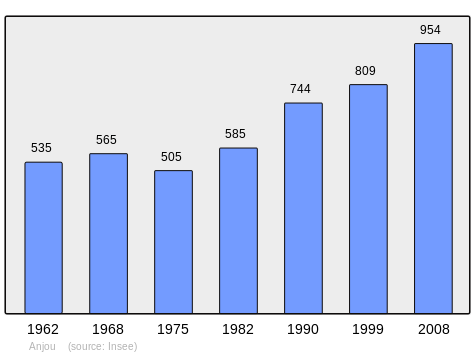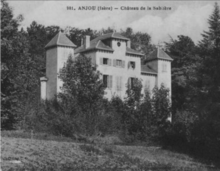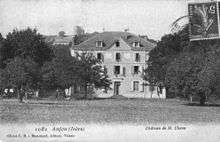Anjou, Isère
| Anjou | ||
|---|---|---|
|
The Church Square in the 19th century | ||
| ||
 Anjou | ||
|
Location within Auvergne-Rhône-Alpes region  Anjou | ||
| Coordinates: 45°20′52″N 4°52′56″E / 45.3478°N 4.8822°ECoordinates: 45°20′52″N 4°52′56″E / 45.3478°N 4.8822°E | ||
| Country | France | |
| Region | Auvergne-Rhône-Alpes | |
| Department | Isère | |
| Arrondissement | Vienne | |
| Canton | Roussillon | |
| Intercommunality | Pays Roussillonnais | |
| Government | ||
| • Mayor (2008–2020) | Denis Rozier | |
| Area1 | 5.03 km2 (1.94 sq mi) | |
| Population (2009)2 | 973 | |
| • Density | 190/km2 (500/sq mi) | |
| Time zone | CET (UTC+1) | |
| • Summer (DST) | CEST (UTC+2) | |
| INSEE/Postal code | 38009 / 38150 | |
| Elevation | 218–383 m (715–1,257 ft) | |
|
1 French Land Register data, which excludes lakes, ponds, glaciers > 1 km² (0.386 sq mi or 247 acres) and river estuaries. 2 Population without double counting: residents of multiple communes (e.g., students and military personnel) only counted once. | ||
Anjou is a French commune in the Isère department in the Auvergne-Rhône-Alpes region of southeastern France.
The inhabitants of the commune are known as Anjoulois or Anjouloises[1]
Geography
Anjou is a commune located in Bas-Dauphiné, some 6 km east by south-east of Roussillon and 10 km north-east of Saint-Rambert-d'Albon. Resting on a south-facing hill and partially sheltered from rain by the peaks of the Pilat mountain range, it benefits from a mild and sunny climate. For many decades, the beauty of its location has drawn numerous tourists and many others who reside in the village.
Access to the commune is by the D51 road from Agnin in the west passing through the commune and the village and continuing to Sonnay in the east.
The Ruisseau de la Ronzee passes through the north of the commune from east to west joining the Ruisseau de la Vescia which forms part of the northern border of the commune and which has several tributaries rising in the commune. An unnamed stream forms the southern border of the commune flowing from east to west.[2]
Neighbouring communes and villages[2]
 |
Ville-sous-Anjou | Assieu | La Chapelle-de-Surieu |  |
| Salaise-sur-Sanne | |
Sonnay | ||
| ||||
| | ||||
| Agnin | Bouge-Chambalud |
Heraldry
.svg.png) |
Blazon: Gules, an eagle Argent. |
Administration
List of Successive Mayors[3]
| From | To | Name | Party | Position |
|---|---|---|---|---|
| 2001 | 2008 | Michel Morel | ||
| 2008 | 2020 | Denis Rozier |
(Not all data is known)
Demography
In 2009 the commune had 973 inhabitants. The evolution of the number of inhabitants is known from the population censuses conducted in the commune since 1793. From the 21st century, a census of communes with fewer than 10,000 inhabitants is held every five years, unlike larger towns that have a sample survey every year.[Note 1]
| 1793 | 1800 | 1806 | 1821 | 1831 | 1836 | 1841 | 1846 | 1851 |
|---|---|---|---|---|---|---|---|---|
| 2,541 | 900 | 1,196 | 825 | 908 | 927 | 872 | 856 | 860 |
| 1856 | 1861 | 1866 | 1872 | 1876 | 1881 | 1886 | 1891 | 1896 |
|---|---|---|---|---|---|---|---|---|
| 900 | 851 | 835 | 801 | 753 | 720 | 691 | 676 | 636 |
| 1901 | 1906 | 1911 | 1921 | 1926 | 1931 | 1936 | 1946 | 1954 |
|---|---|---|---|---|---|---|---|---|
| 614 | 591 | 558 | 522 | 524 | 522 | 503 | 454 | 605 |
| 1962 | 1968 | 1975 | 1982 | 1990 | 1999 | 2006 | 2009 | - |
|---|---|---|---|---|---|---|---|---|
| 535 | 565 | 505 | 585 | 744 | 809 | 931 | 973 | - |
Sources : Ldh/EHESS/Cassini until 1962, INSEE database from 1968 (population without double counting and municipal population from 2006)

Sites and monuments



- The Church was built in the 19th century and its bell tower was completed with two bells cast in Lyon in 1849 and in 1861. This tower has the oldest bell in the region. It originated from the Celestine convent in Lyon which was destroyed during the French Revolution and brought to Anjou by the Bectoz family of Vaubonnais who owned a chateau in the area. A collection of stained glass windows unique for the homogeneity of design and the outstanding quality of the colours is renowned in this building. The Church contains a Commemorative Plaque (1274)
 which is registered as an historical object.[4] Open to the public.
which is registered as an historical object.[4] Open to the public. - The Chateau of Anjou and its 10-hectare park (18th century)
 are registered as historical monuments.[5][6] The remains of the castle and a park created by the famous landscape architects Henri and Achille Duchêne for Clément and Alice Jourdan are open to the public.
are registered as historical monuments.[5][6] The remains of the castle and a park created by the famous landscape architects Henri and Achille Duchêne for Clément and Alice Jourdan are open to the public. - The Fondru Chateau was built in the 19th century and belonged to the Bectoz family of Vaubonnais. It has an attractive dovecote which is undergoing restoration. Not open to the public.
- The Chateau de la Sablière. Not open to the public.
- The Feudal tower of Anjou was part of an old medieval castle from the 12th or 13th centuries. It overlooks the Old Village and the Chateau of Anjou. The tower is today a panoramic site that provides a unique perspective over several departments: Explanatory panels, an orientation table, picnic tables, and toilet facilities available to visitors. Open to the public.
- The Old Village of Anjou has many charming and picturesque lanes including a blacksmith's sign dating to 1666.
- A pedestrian promenade allows the leisurely exploration of the history and culture of Anjou in a day.
Notable people linked to the commune
- Raimon of Anjou, a 12th-century Troubadour in the provençal language, one of the first lords of Anjou.
- Charles IX, King of France (1550-1574) dined at the Anjou Chateau on 15 August 1564.
- Claude Brosse, a famous community trustee of the Dauphine villages, was châtelain of Anjou. In 1639 Louis XIII granted a decree to him rendering fairer assizes (taxes) for the people, or Third-estate. His daughter married Joseph de Bectoz de Vaubonnais and brought him, through her dowry, the Anjou land.
- Melchior Mitte de Chevrières, Count of Anjou, hosted Louis de Bourbon, cousin of Louis XIII and the governor of Dauphiné at his Chateau in Anjou during Christmas celebrations in 1623.
- Louis XIII, King of France, lodged at Anjou Chateau with his entire court on 20 July 1629, during his return from the South.
- Humbert Guillot de Golat, Squire of Garenne, a Dauphinois poet, resided at Anjou where he wrote many poems.
- Sarah Bernhardt visited Anjou in 1887 and stayed at Anjou Chateau at the invitation of Clément and Alice Jourdan.
See also
External links
- Anjou official website (French)
- Anjou on the National Geographic Institute website (French)
- Anjou on Lion1906
- Anjou on Google Maps
- Anjou on Géoportail, National Geographic Institute (IGN) website (French)
- Anjou on the 1750 Cassini Map
- Anjou on the INSEE website (French)
- INSEE (French)
Notes and references
Notes
- ↑ At the beginning of the 21st century, the methods of identification have been modified by law No. 2002-276 of 27 February 2002 , the so-called "law of local democracy" and in particular Title V "census operations" allows, after a transitional period running from 2004 to 2008, the annual publication of the legal population of the different French administrative districts. For communes with a population greater than 10,000 inhabitants, a sample survey is conducted annually, the entire territory of these communes is taken into account at the end of the period of five years. The first "legal population" after 1999 under this new law came into force on 1 January 2009 and was based on the census of 2006.
References
- ↑ Inhabitants of Isère (French)
- 1 2 Google Maps
- ↑ List of Mayors of France
- ↑ Ministry of Culture, Palissy PM38000568 Commemorative Plaque
(French)

- ↑ Ministry of Culture, Mérimée PA38000029 Chateau of Anjou (French)
- ↑ Ministry of Culture, Mérimée IA38000400 Chateau Park (French)
| Wikimedia Commons has media related to Anjou (Isère). |
